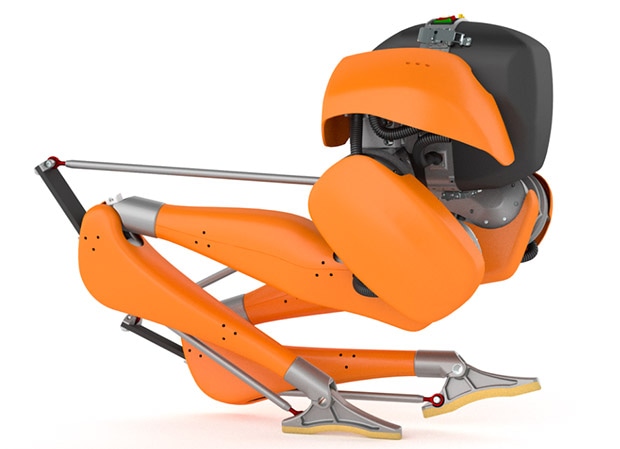 A render of Cassie’s final design, with protective covers. Image: Agility Robotics
A render of Cassie’s final design, with protective covers. Image: Agility Robotics
A startup company founded by researchers from Oregon State University has unveiled a robot that could one day be used for deliveries, dangerous rescue operations or any number of other applications.
Named Cassie, the robot is an upgraded version of a bigger, wonkier robot made by the same team named ATRIAS. The older model was particular hamstrung by a motor system that had some motors working in opposition to each other.
The OSU team performed an extensive mathematical analysis to determine a more efficient leg configuration, which ended up on Cassie. The newer model has motors that are smaller, which translates to a greater overall efficiency than ATRIAS.
In addition to a better motor system, Cassie also has a human-like hip, which allows it to move its legs front-to-back or side-to-side and rotate them concurrently. This gives Cassie much better agility than that of ATRIAS.
Another upgrade from the older model is Cassie’s powered ankles. ARTIAS had to continuously move its feel to stay upright in one place. Cassie’s ankles allow the robot to remain stationary while standing in place.
The result of all those upgrades is a set of legs that look like they were inspired by those of an ostrich. While the engineering team said it wasn’t their intent to mimic the limbs of the flightless bird, they ended up doing so somewhat by accident.
The OSU team behind Cassie has created a startup company called Agility Robotics that is dedicated to refining robotics technology that could one day see widespread use in a variety of applications.
“I believe legged locomotion is going to be analogous to the automotive industry, in terms of size and how it transforms our society,” Agility Robotics’ co-founder Jonathan Hurst recently told IEEE Spectrum. “Cassie is a step in this direction.”
The company said its first Cassie production run has already sold out, and more will be on the market later in the summer. Agility Robotics hasn't disclosed a price tag for Cassie, but has signaled an interest in making the technology available for less than $100,000.
(Cassie) is a first product that will initially be sold to research institutions to support a community of researchers solving the problem of locomotion in the human environment, and Cassie will continue to improve and evolve, as Agility Robotics focuses on products and commercial customers.
Jonathan Hurst, Agility Robotics
With a significant part of our society geared toward bipedal motion, Cassie has the potential to find a wide range of uses, including communication, assisted living, delivery and emergency response applications. However, the robot still needs several upgrades before it can even be considered for any of those uses. Hurst has said his team is currently working on giving Cassie arms, which would allow the robot to get up by itself after a fall.
“This technology will simply explode at some point, when we create vehicles so automated and robots so efficient that deliveries and shipments are almost free,” Hurst predicted in an OSU press release about Cassie. “Quite simply, robots with legs can go a lot of places that wheels cannot. This will be the key to deliveries that can be made 24 hours a day, 365 days a year, by a fleet of autonomous vans that pull up to your curb, and an onboard robot that delivers to your doorstep.”
He added that the “robotics revolution” will bring massive changes to society, possibly much sooner than people think.
We hope for Agility Robotics to be a big part of that revolution. We want to change people’s lives and make them better.
Jonathan Hurst, Agility Robotics
Cassie - Next Generation Robot
Oregon State University/YouTube.com
Disclaimer: The views expressed here are those of the author expressed in their private capacity and do not necessarily represent the views of AZoM.com Limited T/A AZoNetwork the owner and operator of this website. This disclaimer forms part of the Terms and conditions of use of this website.